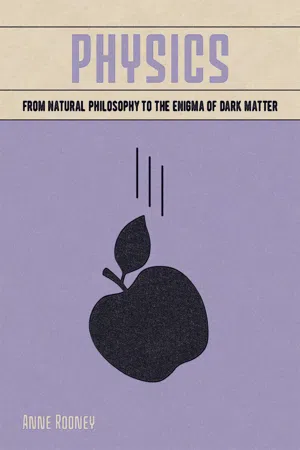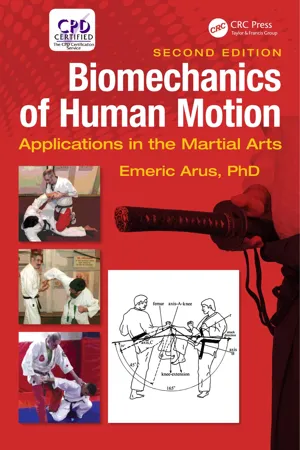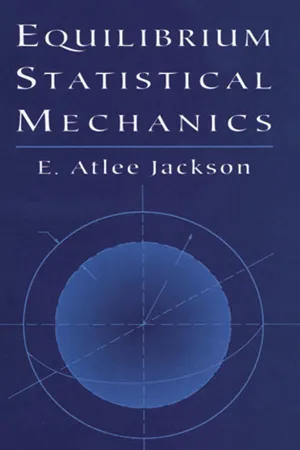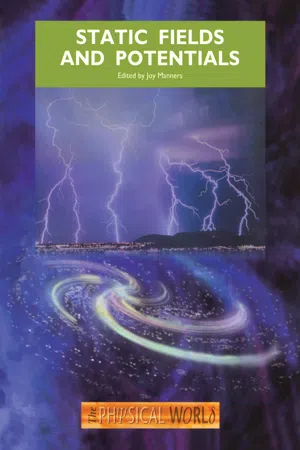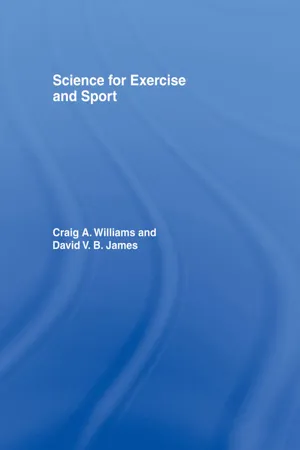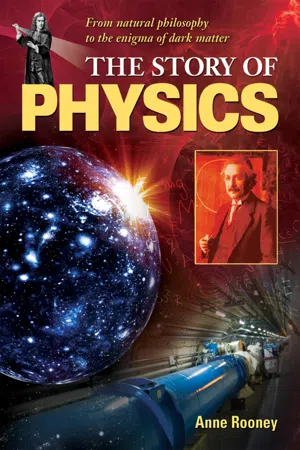Physics
Force and Potential Energy
Force is a push or pull acting on an object, causing it to accelerate. Potential energy is the energy stored in an object due to its position or configuration. In the context of physics, force and potential energy are related concepts, with force being the agent that can change an object's potential energy by doing work on it.
Written by Perlego with AI-assistance
Related key terms
10 Key excerpts on "Force and Potential Energy"
- eBook - ePub
Physics
From Natural Philosophy to the Enigma of Dark Matter
- Anne Rooney(Author)
- 2020(Publication Date)
- Arcturus(Publisher)
CHAPTER 4Energy fields and forces
When a force acts to move a mass it seems obvious to us that energy is involved. So it may seem surprising that for all the consideration of forces since antiquity, energy was largely neglected by the early natural philosophers. The concept of energy is relatively new, emerging only in the 17th century. Indeed, the term ‘energy’ (from the Greek energia , coined by Aristotle) was only introduced with its modern meaning in 1807 by the genius and polymath Thomas Young (of the double-slit experiment). The most obvious forms of energy are light and heat, both of which come for free from the Sun. Humankind has also harnessed chemical energy (released by burning fuels), the gravitational energy of a falling body, the kinetic energy of wind and moving water, and, latterly, electric and nuclear energy.The conservation of energy
Just as matter is conserved, being neither created nor destroyed, so energy too is conserved. It may be converted from one form to another – and this is how we harness energy to do useful work – but that energy is never actually spent. Galileo noticed that a pendulum converts gravitational potential energy into kinetic energy or the energy of movement. When the pendulum bob is at the high point of its swing it is momentarily still, and has maximum potential energy. This is converted into kinetic energy as the bob moves, and the bob regains potential energy as it climbs up on the other side of its swing.‘There is a fact, or if you wish, a law, governing all natural phenomena that are known to date. There is no known exception to this law – it is exact so far as we know. The law is called the conservation of energy.It states that there is a certain quantity, which we call energy, that does not change in manifold changes which nature undergoes. That is a most abstract idea, because it is a mathematical principle; it says that there is a numerical quantity which does not change when something happens. It is not a description of a mechanism, or anything concrete; it is just a strange fact that we can calculate some number and when we finish watching nature go through her tricks and calculate the number again, it is the same.’ - eBook - ePub
Biomechanics of Human Motion
Applications in the Martial Arts, Second Edition
- Emeric Arus, Ph.D.(Authors)
- 2017(Publication Date)
- CRC Press(Publisher)
In our daily life, we often hear talk about energy. Do you say to yourself “I have no energy to finish the job or I need more energy to be able to reach a destination when you are walking on a hill?” The energy is the ability to do work.It is difficult to define energy in precise terms of shape, mass, or size. Rather, the energy suggests a dynamic state related to a condition of change because the presence of energy is revealed only when a change has taken place.There are two kinds of energy: potential and kinetic energy. The potential energy is a stored energy in a body or system. The kinetic energy can be described as the capacity to do work by virtue of the body’s motion. Where is a motion, such as a wind blow, a waterfall, a karateka kick, or the chemical composition of a body with its atoms and molecules that are in motion, there is a kinetic energy (e.g., heat energy). The kinetic energy comes from the potential (stored) energy.We know that there are many different kinds of energy such as chemical, electrical, light, wind, thermonuclear, water, and mechanical energy. According to the law of thermodynamics (conservation of energy ), which states that in any system not involving nuclear reactions or velocities approaching the velocity of light, energy cannot be created or destroyed but can be lost. An athlete can lose or deplete his energy if he does not adequately supply it by means of meal, drink, or rest.Let us analyze the potential energy a little bit more, noted with PE or U . U also represents work. We can see or realize that when an object has been moved to a certain distance and it has the tendency to return to its original position due to a force, which is also often called a restoring force , it represents a stored energy called the potential energy. For example, a stretched spring has the tendency to return to its original position due to potential energy. Another example is that when a weight is lifted up to a certain height, the force of gravity will try to bring it back to its original position due to the gravitational potential energy. - eBook - ePub
Newtonian Dynamics
An Introduction
- Richard Fitzpatrick(Author)
- 2021(Publication Date)
- CRC Press(Publisher)
U represents some form of potential energy.The previous discussion leads to the following important conclusions. First, it should be possible to associate a potential energy (i.e., an energy a body possesses by virtue of its position) with any conservative force-field. Second, any force-field for which we can define a potential energy must necessarily be conservative. For instance, the existence of gravitational potential energy proves that gravitational fields are conservative. Third, the concept of potential energy is meaningless in a non-conservative force-field (because the potential energy at a given point cannot be uniquely defined). Fourth, potential energy is only defined to within an arbitrary additive constant. In other words, the point in space at which we set the potential energy to zero can be chosen at will. This implies that only differences in potential energies between different points in space have any physical significance. For instance, we have seen that the definition of gravitational potential energy isU = m g z, where z represents height above sea level. However, we could just as well writeU = m g ( z −, where z0 is the height of some arbitrarily chosen reference point (e.g., the top of Mount Everest, or the bottom of the Dead Sea). Fifth, the difference in potential energy between two points represents the net energy transferred to the associated force-field when a body moves between these two points. In other words, potential energy is not, strictly speaking, a property of the body; instead, it is a property of the force-field within which the body moves.z 0)5.6 Hooke’s Law
Consider a mass, m, that slides over a horizontal frictionless surface. Suppose that the mass is attached to a light horizontal spring whose other end is anchored to an immovable object. See Figure 5.8 . Let x be the extension of the spring; that is, the difference between the spring’s actual length and its unstretched length. Obviously, x can also be used as a coordinate to determine the horizontal displacement of the mass. According to Hooke’s law, the force, f - eBook - ePub
- E. Atlee Jackson(Author)
- 2012(Publication Date)
- Dover Publications(Publisher)
Some of these limitations due to quantum-mechanical effects will be taken up in Section 5. Before considering the interaction between particles, we should first define the kinetic and potential energy of a collection of noninteracting particles (they do not exist, of course, but it is often useful to consider such a model). If a system contains N particles, the total kinetic energy is defined simply as the sum of the individual kinetic energies of the particles: (16) where m i, v i) is the mass and velocity of particle i. Moreover, if these particles are in an external (conservative) force field, such as an electric field or gravity, then the total potential energy due to these forces is again the sum of their individual potential energies: (17) Note that, just as E kin depends on the value of each velocity v i, φ ext depends on the position of each particle r i. Now we turn to the question of the interactions between particles and between molecules. Just as we can describe conservative external forces in terms of a potential energy Φ (r i), we can frequently represent the intermolecular forces by a potential energy Φ(r ij). In this case r ij = r i − r j = [(x i − x j) 2 + (y i − y i) 2 + (z i − z i) 2 ] 1/2 is the distance between the molecules, and the force on particle i (due to particle j) is given by If the potential depends only on the magnitude of the separation between the molecules, then (18) and the force is along their connecting line, as illustrated in Figure 4. Note that F i = − F j, so the forces are equal but in opposite directions. Figure 4. Intermolecular forces The intermolecular forces can be conveniently divided into repulsive forces and attractive forces. These repulsive forces may originate in electrical forces, nuclear forces, or certain quantum-mechanical effects. For example, when two neutral atoms come very close together, the electrons around each atom begin to overlap - eBook - ePub
- A. L. Stanford, J. M. Tanner(Authors)
- 2014(Publication Date)
- Academic Press(Publisher)
0→8 is 1300 J. Then we obtainv 8 2=12 2+ 2( 1300 )/ 10 = 400v 8= 20 m / sPotential Energy
We have seen that the kinetic energy of a particle depends on the mass and speed of that particle. Although we usually measure the speed of a particle relative to the earth, the kinetic energy of that particle is associated with the particle itself. Now we consider a second form of mechanical energy called potential energy . Like kinetic energy, potential energy represents the ability to do work. But potential energy arises because of interactions between two or more bodies. Thus the potential energy of a system of interacting objects represents the ability of the system to do work because of its configuration.Here we shall consider two forms of mechanical potential energy: gravitational and elastic. The gravitational potential energy that we shall associate with a particle arises from the configuration of the particle and the earth, a system that is interacting by means of the gravitational force. Elastic energy, on the other hand, arises from the configuration of a spring or some similar device that may have the ability to do work in stressed configurations. Let us examine gravitational potential energy first.Gravitational Potential Energy
A particle anywhere outside the earth interacts with the earth through the attractive gravitational forces on the particle and the earth. We shall, for convenience, separate the special case of a particle near the surface of the earth from the more general case because many of the situations we encounter occur near the surface of the earth.Let us consider first the near-earth situation, in which the magnitude g of the free-fall acceleration of a body is constant. We designate some reference position along the vertical to be y = 0. This arbitrary choice gives us a reference level from which vertical distances may be measured. Let us define the gravitational potential energy of a particle to be zero at the reference level y = 0. At any other vertical position, such as y = h , the gravitational potential energy is defined to be the work that the gravitational force would do on the particle if the particle were moved from a position at y = h to the reference level y - eBook - ePub
- Joy Manners(Author)
- 2020(Publication Date)
- CRC Press(Publisher)
potential energy associated with the electrostatic (Coulomb) force and the gravitational force.You should know from the mechanics books Describing motion and Predicting motion that, when a constant force F acts on an object that moves through a displacement s, the energy transferred to the object is given by F·s. Any object that moves around in some kind of force field must, therefore, experience changes in its energy. If the force field is conservative, then the work done in moving from one point to another will be independent of the path followed, and it will be possible to associate a potential energy with each configuration of the system. In this way, if an object is moved against some conservative force, for example, if a mass is raised from the floor to a certain height, or if a positive charge is moved towards another positive charge, then that object's potential energy must increase. In a uniform field such as the gravitational field near the surface of the Earth, this increase is easy to calculate. When an object of mass m is raised through a height ∆h, the increase in potential energy is mg ∆h, where g is the magnitude of the acceleration due to gravity. This energy change is interpreted as a change in the gravitational potential energy of the object. The energy is described as potential energy because, if the object is subsequently released and allowed to fall freely under the influence of gravity, then the potential energy is recovered in the form of kinetic energy after the object has fallen through the vertical height ∆h. - No longer available |Learn more
- Robert A. Pelcovits, Joshua Farkas(Authors)
- 2023(Publication Date)
- Barrons Educational Services(Publisher)
4Work, Energy, and Power
Learning Objectives
In this chapter, you will learn:Definition of work, kinetic and potential energy, and powerWork-energy theoremConservative and nonconservative forcesHooke’s law and elastic potential energyConservation of mechanical energyEnergy diagramsWork
The work done on a body by a single external force F is defined by the equationThe definition of work by one forceWhat if n external forces are acting on an object at the same time? Because of the principle of superposition of forces, the net work isWork due to multiple forcesWhen this expression is expanded, we find that the net work is equal to the algebraic sum of the work done by each individual force. (Recall that A · B + C · B = (A + C) · B.)Work due to multiple forcesThus, to calculate the net work done by multiple forces, we can (1) calculate the work done by each force and sum these individual works, or (2) calculate the net force and compute the work done by the net force using the equation dW = Fnet · dr.Work (and energy) has units of newton · meter, which is defined to be a joule (J = N · m = kg·m2 /s2 ).Because work is equal to the dot product of the net force and the displacement vector, it is a scalar whose magnitude and sign are determined by the component of the net force parallel to the direction of motion. This can be shown explicitly by resolving the force into components parallel and perpendicular to the displacement vector and expanding the dot product:There are three sign possibilities for work, which correspond to the three different situations discussed below. This following discussion can be understood based on the fact that the displacement vector dr is parallel to the velocity and on our discussion of tangential acceleration (which affects an object’s speed) and centripetal acceleration (which affects an object’s direction) from Chapter 2 - eBook - ePub
- David James, Craig Williams(Authors)
- 2014(Publication Date)
- Routledge(Publisher)
kinetic energy.Potential energy is calculated by multiplying the mass (in kg) of an object by the acceleration due to gravity (in m·s−2 ) acting on the object and the vertical displacement (i.e. height) of the object (in m) (see Equation 6.4 ). Kinetic energy is calculated by dividing the mass (in kg) of an object by 2, and then multiplying by the square of the velocity (in m·s−1 ) (see Equation 6.5 ).The transformation of energy between potential and kinetic forms can also be observed when elastic is stretched and then released. As the elastic is stretched it gains potential energy, which is known as strain energy. The maximal gain in strain energy is reached just before the elastic reaches its elastic limit, otherwise known as the yield point (beyond this point energy is lost and the elastic takes on plastic properties). If the elastic is then released, potential energy is converted to kinetic energy. The change in length of elastic (m) is proportional to the force applied (N), a relationship known as Hooke’s law (see Equation 6.6 ).The gain in strain energy is related to the ability of the elastic to store energy on lengthening (k ) and the change in length of the elastic (x ) (see Equation 6.7 ).The mechanical properties of muscle and connective tissue are very much like those of elastic, except for a damping effect (i.e. a shock absorber effect). In Application 2 at the end of this chapter, the effects of these properties of muscle and connective tissue are examined. Try to investigate the contribution of the elastic properties of the muscle and connective tissue in your own legs by comparing the height jumped with two jumping techniques. First try a vertical jump starting from a crouched position (i.e. with your legs bent). Secondly try a vertical jump starting from a standing position. You will observe that the height jumped using the second technique is greater due to the elastic contribution of the muscle and connective tissue in the legs. Kangaroos make extremely good use of the elastic properties of the tendons in their legs, to the extent that they become slightly more efficient as their speed increases. - eBook - ePub
- Anne Rooney(Author)
- 2014(Publication Date)
- Arcturus(Publisher)
CHAPTER 4
ENERGY
fields and forces
Lightning and wind represent massive bursts of energy in nature, feared for their destructive powerWhen a force acts to move a mass it seems obvious to us that energy is involved. So it may seem surprising that for all the consideration of forces since antiquity, energy was largely neglected by the early natural philosophers. The concept of energy is relatively new, emerging only in the 17th century. Indeed, the term ‘energy’ (from the Greekenergia, coined by Aristotle) was only introduced with its modern meaning in 1807 by the genius and polymath Thomas Young (of the double-slit experiment). The most obvious forms of energy are light and heat, both of which come for free from the sun. Humankind has also harnessed chemical energy (released by burning fuels), the gravitational energy of a falling body, the kinetic energy of wind and moving water, and, latterly, electric and nuclear energy.The conservation of energy
Just as matter is conserved, being neither created nor destroyed, so energy too is conserved. It may be converted from one form to another – and this is how we harness energy to do useful work – but that energy is never actually spent. Galileo noticed that a pendulum converts gravitational potential energy into kinetic energy or the energy of movement. When the pendulum bob is at the high point of its swing it is momentarily still, and has maximum potential energy. This is converted into kinetic energy as the bob moves, and the bob regains potential energy as it climbs up on the other side of its swing.Pendulum clocks were first developed in 1656 by Christiaan Huygens: the pendulum always takes the same time to swingINVENTING ‘ENERGY ’
That different types of energy are equivalent was not immediately obvious. Even now there is no fundamental understanding of exactly what energy is and how it works. The German mathematician Gottfried Leibnitz (1646–1716) explained mathematically the conversion between different types of energy, which he called vis viva. - eBook - ePub
- Craig Williams, David James, Cassie Wilson(Authors)
- 2008(Publication Date)
- Routledge(Publisher)
We can find examples of the transformation of energy during exercise and sport. A simple example is the pole-vault. As the pole-vaulter approaches the take-off, the pole-vaulter has generated much kinetic energy in a horizontal direction. As the pole is deformed, most of the pole-vaulter’s kinetic energy is converted to potential energy in the pole. As the pole-vaulter is propelled upwards, the potential energy stored within the pole is converted to kinetic energy of the pole-vaulter once again, but in a vertical direction. When passing over the bar, the pole-vaulter has maximum potential energy, since all the kinetic energy has been converted to potential energy.WORK
Essentially, in terms of physical activity, work is the useful end product of the chemical energy used. The useful work done by the body can be accurately measured in some types of activity. It is when the useful work done by the body is compared with the chemical energy used, that a measure of the body’s work efficiency is obtained (see efficiency section, p. 94).Work is measured in joules (J) (the same unit of measurement as used for energy), and is calculated by multiplying the distance an object is displaced (in metres, m) by the force opposing the displacement (in newtons, N) (see Equation 6.8 and Figure 6.2 ). Notice the similarity with equation 6.1.(6.8)At this point it is clear to see that 1 newton metre is the same as 1 joule (i.e. 1 N.m = 1 J).In many exercise and sport situations, it is difficult to assess the amount of useful work done. It was for this reason that a standardised situation was set up in exercise and sport laboratories where the useful work done by an individual could be determined. The situation is described in detail in application three (see p. 96).It is very difficult to directly determine the useful work done by a runner, but since running is a very common mode of exercise, such a measure would be useful. Various attempts have been made to crudely estimate the work done by a runner, one of which is described below, and another is given in application two (see p. 96).
Index pages curate the most relevant extracts from our library of academic textbooks. They’ve been created using an in-house natural language model (NLM), each adding context and meaning to key research topics.
